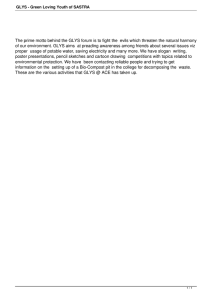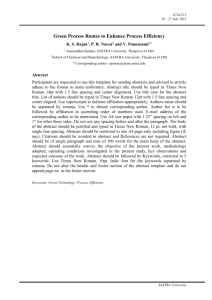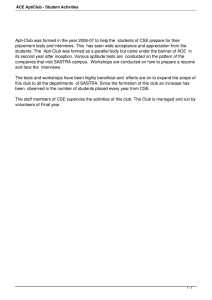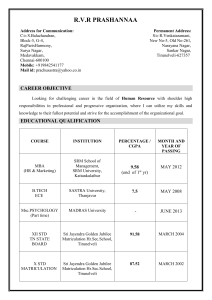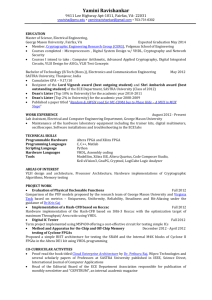Computer Network Security P.S.Dhekne BARC
advertisement
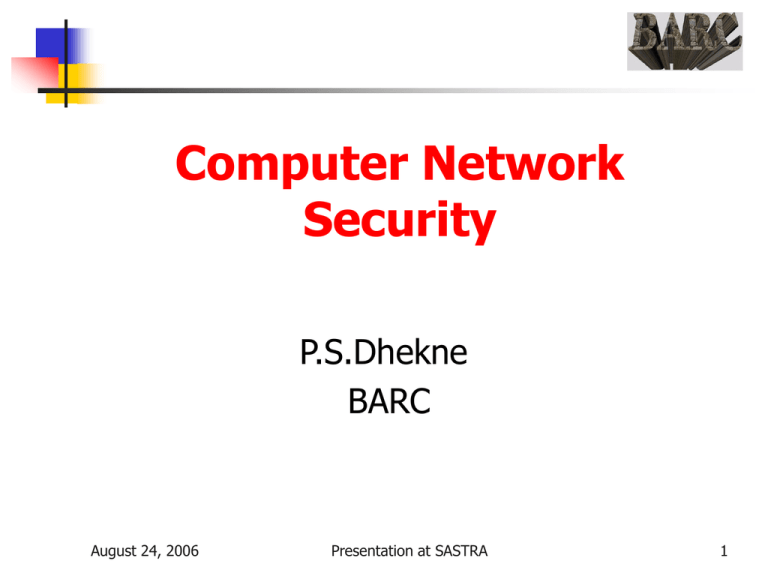
Computer Network Security P.S.Dhekne BARC August 24, 2006 Presentation at SASTRA 1 Organization What is Security all about? What is at Risk? Why Risks Exist? General Threat Perceptions Security Data (local, Remote) Communications Secure Backup August 24, 2006 Network Perimeter Security General Policy Min. Security Enforcement Intrusion Detection System Cryptographic Security VPN: A Roadmap Points for Action Emergency Response Team Presentation at SASTRA 2 INFORMATION SECURITY • The information systems are known to be vulnerable to many threats like cyber crime, hacking and terrorism • Regardless of whether the information has been stolen by the attacker or not, the security breaches and virus attacks result in adverse publicity to the organization. •Thus issues like protection and security of the information systems have become greater concern. August 24, 2006 Presentation at SASTRA 3 Some Harsh Facts : (IDC report) • 85% detected computer security breaches within the last twelve months. • 64% acknowledged financial losses due to computer breaches. • 36% reported the intrusions to law enforcement; a significant increase from 2000, when only 25% reported them. August 24, 2006 Presentation at SASTRA 4 INFORMATION SECURITY • Information & Network penetration do occur - from outsiders & insiders in spite of having various security measures such as Anti-virus, Firewalls, Routers • There are two ways to attack computers - Gain physical access to machines & conduct physical attack - Attack by use of malicious software; Malware August 24, 2006 Presentation at SASTRA 5 What is Security all about? Confidentiality: Integrity: Not modified/destroyed in a unauthorized way; safeguarding the accuracy & completeness of information & software Access Control: Protecting sensitive information from unauthorized disclosure or intelligible interception; Only seen by entities to whom it is addressed Access (computation, data, service) follows the prescribed policy Authentication: Verifying the identity claimed August 24, 2006 Presentation at SASTRA 6 What is Security All About? Availability: Nonrepudiation: Protection against false denial of comm. Audit Trail: System accessible/usable on demand Chronological record of system activities to enable reconstruction/examination of environments/activities leading to an operation from inception to final results. Privacy: Breach of confidentiality is also invasion of privacy. Collecting a dossier based upon his activities - inferring habits, movements, expenditures Security Risk August 24, 2006 Presentation at SASTRA 7 What is at Risk? Data, Time and Money 1. Obvious: deletion/modification of data Slowly modifying data so that breach is not discovered right away Using Service providers’ software (say a online brokers CD software) – provides flexibility than by standard browsers. However it is a golden opportunity for an attacker with the knowledge of how that software works. August 24, 2006 Presentation at SASTRA 8 What is at Risk? (Contd) 2. Confidentiality Data disclosure is often overlooked risk A breach of confidentiality is much less likely to be discovered than the deletion of data Best Defence: well-designed cryptographic protected system – note that the data must be in the clear at some point (it is here attacker can get in …) August 24, 2006 Presentation at SASTRA 9 What is at Risk? (Contd) Privacy: 3. • One of the things that is risk in today’s computerized and networked world. Resource Availability: 4. • Denial of Service attacks August 24, 2006 Presentation at SASTRA 10 Why Risks Exist? Erroneous Program The user (Systems should be User proof!) Lack of prudent Software Engineering Practices Complexity of software (millions of lines) Urgently developed Components of The Shelf (COTS) Responsibility lies with the user (ignorance/non cooperation are problems) Security policy should convince the users Poor Administration Configuration, backup procedures, constant updates, monitoring, disaster recovery … August 24, 2006 Presentation at SASTRA 11 General Threat Perceptions Network threatened by external running malicious scripts (Malware) Adversaries attempting access protected services, break into machines, snoop communications, collect statistics of transactions … Insiders and outsiders Disasters (natural and man-made) August 24, 2006 Presentation at SASTRA 12 Secure Storing of Data (Local Storage) Physical Security Protect machine Limit network access Most secure (without external access) Suppose it falls into an adversary All the data can be obtained in the clear August 24, 2006 Cryptographic Secure. Protects even if the m/c falls to adversary Of course person having access can delete -Hence, BACKUP Data Integrity Cryptography: Fragile Presentation at SASTRA System issues, user interfaces , Crypto-file servers … 13 Secure Storing of Data (Remote Storage) Need (also advantages!): Data protected from local disk failure Sharing of files Centralized administration and backup Use of diskless workstations Adding Security: passwords, cryptography, access control lists, capabilities Physical security (Key servers etc) August 24, 2006 Presentation at SASTRA 14 Secure Backup Prevent what you cannot detect and detect what you cannot prevent Security of the backup itself Backup over a network Cryptographic encryption Key servers Incremental Backup Deleting Backups August 24, 2006 Presentation at SASTRA 15 Secure Communication Cryptography Encryption/decryption Key management Session key protocols Public Key Infrastructures Certification Digital Signatures August 24, 2006 Presentation at SASTRA 16 Replay Prevention Replay attacks are simple yet very effective Records a message say from A to B, and later replays it to impersonate A Attack is effective as attacker need not decrypt Needs to be addressed regardless of layer chosen August 24, 2006 Presentation at SASTRA 17 Network Perimeter Security (Protection from Outsiders) General (Policies to be enforced) Policies delineating appropriate and inappropriate behaviour Security Classification of data and Machines and enforce access controls Only required access to be given to insiders Enforce Physical security for file servers, secure nodes, key servers, authentication servers, backups etc. Audit Procedures (manual and automated) August 24, 2006 Presentation at SASTRA 18 Network Perimeter Security (Min. Security Enforcement) External Access: Minimum Standards for Hardware Software Standards: OS, Browsers, Compilers, Tools – prefer open source Secure Configuration One point access: Internet, Dialups (callbacks), Broadband, DSL, wireless …; violation only with cryptographic encryption email, mobile agents/systems, only required ports to be open, restrictions on shell (corresponding to required security levels) Viruses (continuous protection) Denial of Service Protection August 24, 2006 Presentation at SASTRA 19 Minimum Security (contd) Web Security: embarrassing quite often; Have Exit Control (ensures web modifications through authentication) Check Mirror sites periodically Auditing the usage and traffic Backup (automatic, mirroring, remote, …) and disaster recovery -- Perhaps use August 24, 2006 Presentation at SASTRA 20 Intrusion Detection Systems Attack detection, with automated response Damage prevention and containment Tracing and isolation of attack origin points Mimic hackers attacking networks (including ISPs) continuously highlighting dangerous infrastructure flaws that could cripple the system Leads to required Upgrades in Security Leads to next generation design of devices August 24, 2006 Presentation at SASTRA 21 Certification: Key Servers, PKI Infrastructure Needed security Authenticated usage Via parameters identified in the policy Computing Data Backup of Data and its integrity Online offline August 24, 2006 Presentation at SASTRA 22 Securing Communication August 24, 2006 Trusted sites Use of public network Secure channels Transparent to users Presentation at SASTRA 23 Virtual Private Network:VPN Secure use of public communication channel with Off the shelf hardware IP tunneling Software encryption August 24, 2006 Presentation at SASTRA 24 Basic VPN Fixed encryption algorithm Static keys per pair of sites An encrypting PC router per site Off the shelf hardware Custom software Secures communication between sites August 24, 2006 Presentation at SASTRA 25 Managing the VPN Introduce key servers Manage dynamic keys on the network Customize encryption algorithms Involves software upgrades at each site. Provide a scalable management model August 24, 2006 Presentation at SASTRA 26 Tighten Exit Security Fake traffic on the links Reroute traffic Insulate from statistical inferences August 24, 2006 Presentation at SASTRA 27 Internal Security Introduce encryption within a site Involves software upgrades to the OS Minimize damage from within (may be crypto fileservers) August 24, 2006 Presentation at SASTRA 28 Points for action Policy Access Control and Log Encryption Certification Backup Teams August 24, 2006 Routine Audit and Management Structure Emergency Response Team Dynamic IDS and Crypto-Systems Work Presentation at SASTRA 29 Emergency Response Team Plan • Person on firecall and in-charge • Reaction to security breach. • Internal expertise • If not alternatives • Determine chain of command August 24, 2006 Presentation at SASTRA 30 COST OF UNPROTECTED ENVIRONMENT - Loss of data - Loss of server up time - Loss of user's productivity - Loss of money Average cost per virus encounter US $ 2454 How much protection is enough ? No one knows!! August 24, 2006 Presentation at SASTRA 31 Information Security Management System (ISMS) Organization Security Security Policy Personnel Security Physical & Environmental security Asset Classification & Control Communications & Operations Management Access Control System Development & Maint. Security Standard Compliance: IS 15150/27001 August 24, 2006 Presentation at SASTRA 32 Information Security Approach Secure Network Design, Layered approach (Defense in Depth concept), SPF and Application firewalls Harden the Operating System Use Secure Applications with Secure Configurations Centralized logging and Monitoring Intrusion Detection System (HIDS,NIDS) Encryption Local Vulnerability tests, self auditing August 24, 2006 Presentation at SASTRA 33 Secured Multi-layered Network Design Via VPN 2 Mbps Router/Firewall IDS WWW server 202.41.86.x PROXY Server Internet Mail Gateway DMZ DNS server 192.168.x.x IDS Centralized Log server And SMS Internal Email Server NAT Firewall 10.x.x.x IDS PC HDSL Modems Remote Access Server PC Browsing PCs ISDN Exchange PC ISDN lines HDSL Modems PC PC Browsing PCs August 24, 2006 Presentation at SASTRA PC PC PC Browsing PCs 34 SECURITY BUILDING BLOCKS Authentication (passwords, biometric devices) Encryption - so that unauthorized user cannot make sense of the data even if he intercepts it. Access control - a policy by the organization to decide who has access to what. Key management - the properties of the encryption/decryption keys. Resource isolation- so that damage is contained. Network Perimeter Protection – Firewall, NAT August 24, 2006 Presentation at SASTRA 35 Use of Secure Software Centralized Logging and Security Monitoring System Web-Pages Integrity check module for Apache WebServer Securing Web Server Securing Mail-gateways Securing DNS servers August 24, 2006 Use of Public Domain Firewalls, Proxy and NAT servers with value additions Presentation at SASTRA 36 Intrusion Detection System Host Intrusion Detection System Security Monitoring System Developed at BARC Network Intrusion Detection System Open Source SNORT IDS implemented with rule set customized for our environment. August 24, 2006 Presentation at SASTRA 37 Web Based Security Monitoring & IDS BARC has developed a Web based Security Monitoring & Intrusion Detection System For monitoring security of routers, all Internet connected servers and related software packages on a continuous basis. This software tool can detect network attacks in real-time by analyzing various log files and known signatures It allows system administrator to take appropriate corrective action before any damage to information can be caused by setting an alarm. August 24, 2006 Presentation at SASTRA 38 Central Administration & Monitoring To ensure that IT Security policies within a organization are properly implemented, it is necessary to conduct periodic audits Need powerful automated tools for Auditing Intrusion detection Performance measurement And to find a variety of threats, vulnerabilities and advance warning for any penetration that might occur August 24, 2006 Presentation at SASTRA 39 Centralized logging & Monitoring System • All Internet Servers, routers logs are collected on centralized log server • Logs are parsed for abnormal events on Routers, Internet connected hosts • All incoming/outgoing mail archived • Mail logs are parsed for generating Mail usage, abnormal event statistics • Proxy server logs are parsed for generating proxy server usage statistics August 24, 2006 Presentation at SASTRA 40 August 24, 2006 Presentation at SASTRA 41
